Anfeng Xu
Joint ASR and Speaker Role Tagging with Serialized Output Training
Jun 12, 2025Abstract:Automatic Speech Recognition systems have made significant progress with large-scale pre-trained models. However, most current systems focus solely on transcribing the speech without identifying speaker roles, a function that is critical for conversational AI. In this work, we investigate the use of serialized output training (SOT) for joint ASR and speaker role tagging. By augmenting Whisper with role-specific tokens and fine-tuning it with SOT, we enable the model to generate role-aware transcriptions in a single decoding pass. We compare the SOT approach against a self-supervised previous baseline method on two real-world conversational datasets. Our findings show that this approach achieves more than 10% reduction in multi-talker WER, demonstrating its feasibility as a unified model for speaker-role aware speech transcription.
Large Language Models based ASR Error Correction for Child Conversations
May 22, 2025Abstract:Automatic Speech Recognition (ASR) has recently shown remarkable progress, but accurately transcribing children's speech remains a significant challenge. Recent developments in Large Language Models (LLMs) have shown promise in improving ASR transcriptions. However, their applications in child speech including conversational scenarios are underexplored. In this study, we explore the use of LLMs in correcting ASR errors for conversational child speech. We demonstrate the promises and challenges of LLMs through experiments on two children's conversational speech datasets with both zero-shot and fine-tuned ASR outputs. We find that while LLMs are helpful in correcting zero-shot ASR outputs and fine-tuned CTC-based ASR outputs, it remains challenging for LLMs to improve ASR performance when incorporating contextual information or when using fine-tuned autoregressive ASR (e.g., Whisper) outputs.
Vox-Profile: A Speech Foundation Model Benchmark for Characterizing Diverse Speaker and Speech Traits
May 20, 2025Abstract:We introduce Vox-Profile, a comprehensive benchmark to characterize rich speaker and speech traits using speech foundation models. Unlike existing works that focus on a single dimension of speaker traits, Vox-Profile provides holistic and multi-dimensional profiles that reflect both static speaker traits (e.g., age, sex, accent) and dynamic speech properties (e.g., emotion, speech flow). This benchmark is grounded in speech science and linguistics, developed with domain experts to accurately index speaker and speech characteristics. We report benchmark experiments using over 15 publicly available speech datasets and several widely used speech foundation models that target various static and dynamic speaker and speech properties. In addition to benchmark experiments, we showcase several downstream applications supported by Vox-Profile. First, we show that Vox-Profile can augment existing speech recognition datasets to analyze ASR performance variability. Vox-Profile is also used as a tool to evaluate the performance of speech generation systems. Finally, we assess the quality of our automated profiles through comparison with human evaluation and show convergent validity. Vox-Profile is publicly available at: https://github.com/tiantiaf0627/vox-profile-release.
Who Said What WSW 2.0? Enhanced Automated Analysis of Preschool Classroom Speech
May 15, 2025



Abstract:This paper introduces an automated framework WSW2.0 for analyzing vocal interactions in preschool classrooms, enhancing both accuracy and scalability through the integration of wav2vec2-based speaker classification and Whisper (large-v2 and large-v3) speech transcription. A total of 235 minutes of audio recordings (160 minutes from 12 children and 75 minutes from 5 teachers), were used to compare system outputs to expert human annotations. WSW2.0 achieves a weighted F1 score of .845, accuracy of .846, and an error-corrected kappa of .672 for speaker classification (child vs. teacher). Transcription quality is moderate to high with word error rates of .119 for teachers and .238 for children. WSW2.0 exhibits relatively high absolute agreement intraclass correlations (ICC) with expert transcriptions for a range of classroom language features. These include teacher and child mean utterance length, lexical diversity, question asking, and responses to questions and other utterances, which show absolute agreement intraclass correlations between .64 and .98. To establish scalability, we apply the framework to an extensive dataset spanning two years and over 1,592 hours of classroom audio recordings, demonstrating the framework's robustness for broad real-world applications. These findings highlight the potential of deep learning and natural language processing techniques to revolutionize educational research by providing accurate measures of key features of preschool classroom speech, ultimately guiding more effective intervention strategies and supporting early childhood language development.
Can Generic LLMs Help Analyze Child-adult Interactions Involving Children with Autism in Clinical Observation?
Nov 16, 2024Abstract:Large Language Models (LLMs) have shown significant potential in understanding human communication and interaction. However, their performance in the domain of child-inclusive interactions, including in clinical settings, remains less explored. In this work, we evaluate generic LLMs' ability to analyze child-adult dyadic interactions in a clinically relevant context involving children with ASD. Specifically, we explore LLMs in performing four tasks: classifying child-adult utterances, predicting engaged activities, recognizing language skills and understanding traits that are clinically relevant. Our evaluation shows that generic LLMs are highly capable of analyzing long and complex conversations in clinical observation sessions, often surpassing the performance of non-expert human evaluators. The results show their potential to segment interactions of interest, assist in language skills evaluation, identify engaged activities, and offer clinical-relevant context for assessments.
Egocentric Speaker Classification in Child-Adult Dyadic Interactions: From Sensing to Computational Modeling
Sep 14, 2024
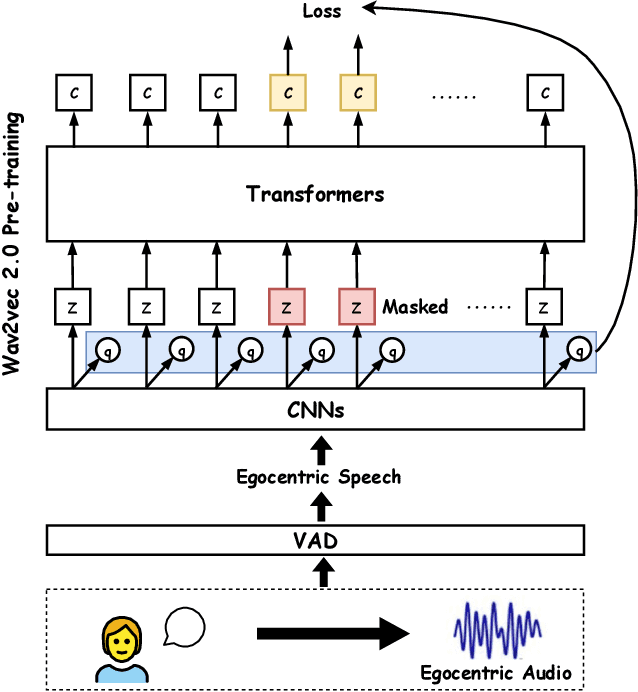
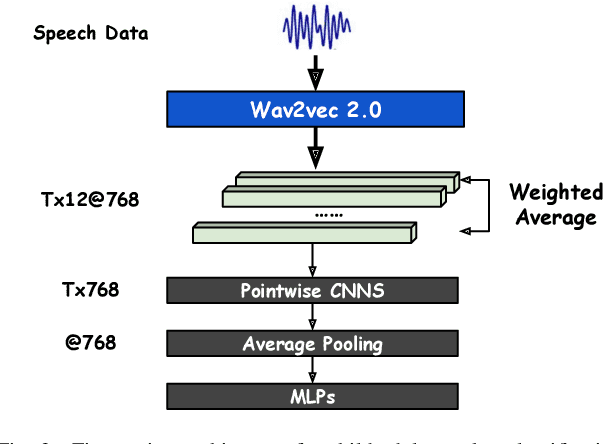
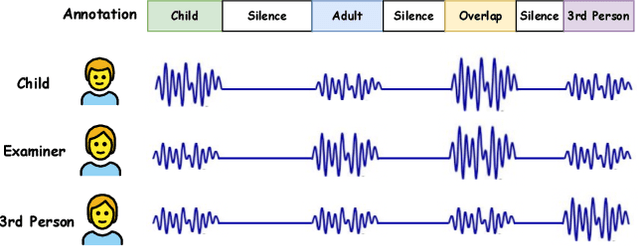
Abstract:Autism spectrum disorder (ASD) is a neurodevelopmental condition characterized by challenges in social communication, repetitive behavior, and sensory processing. One important research area in ASD is evaluating children's behavioral changes over time during treatment. The standard protocol with this objective is BOSCC, which involves dyadic interactions between a child and clinicians performing a pre-defined set of activities. A fundamental aspect of understanding children's behavior in these interactions is automatic speech understanding, particularly identifying who speaks and when. Conventional approaches in this area heavily rely on speech samples recorded from a spectator perspective, and there is limited research on egocentric speech modeling. In this study, we design an experiment to perform speech sampling in BOSCC interviews from an egocentric perspective using wearable sensors and explore pre-training Ego4D speech samples to enhance child-adult speaker classification in dyadic interactions. Our findings highlight the potential of egocentric speech collection and pre-training to improve speaker classification accuracy.
Data Efficient Child-Adult Speaker Diarization with Simulated Conversations
Sep 13, 2024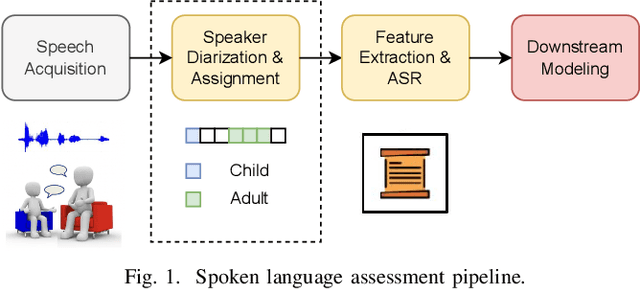
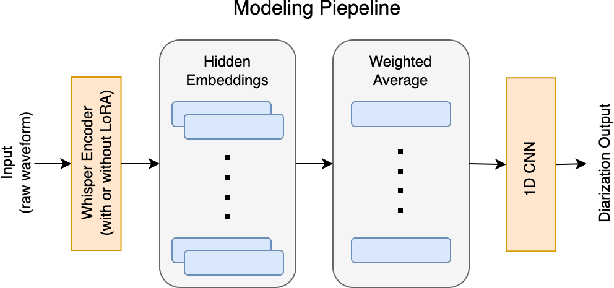

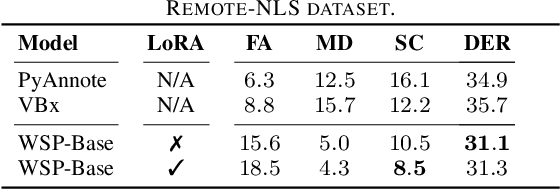
Abstract:Automating child speech analysis is crucial for applications such as neurocognitive assessments. Speaker diarization, which identifies ``who spoke when'', is an essential component of the automated analysis. However, publicly available child-adult speaker diarization solutions are scarce due to privacy concerns and a lack of annotated datasets, while manually annotating data for each scenario is both time-consuming and costly. To overcome these challenges, we propose a data-efficient solution by creating simulated child-adult conversations using AudioSet. We then train a Whisper Encoder-based model, achieving strong zero-shot performance on child-adult speaker diarization using real datasets. The model performance improves substantially when fine-tuned with only 30 minutes of real train data, with LoRA further improving the transfer learning performance. The source code and the child-adult speaker diarization model trained on simulated conversations are publicly available.
Effective Integration of KAN for Keyword Spotting
Sep 13, 2024Abstract:Keyword spotting (KWS) is an important speech processing component for smart devices with voice assistance capability. In this paper, we investigate if Kolmogorov-Arnold Networks (KAN) can be used to enhance the performance of KWS. We explore various approaches to integrate KAN for a model architecture based on 1D Convolutional Neural Networks (CNN). We find that KAN is effective at modeling high-level features in lower-dimensional spaces, resulting in improved KWS performance when integrated appropriately. The findings shed light on understanding KAN for speech processing tasks and on other modalities for future researchers.
Exploring Speech Foundation Models for Speaker Diarization in Child-Adult Dyadic Interactions
Jun 12, 2024Abstract:Speech foundation models, trained on vast datasets, have opened unique opportunities in addressing challenging low-resource speech understanding, such as child speech. In this work, we explore the capabilities of speech foundation models on child-adult speaker diarization. We show that exemplary foundation models can achieve 39.5% and 62.3% relative reductions in Diarization Error Rate and Speaker Confusion Rate, respectively, compared to previous speaker diarization methods. In addition, we benchmark and evaluate the speaker diarization results of the speech foundation models with varying the input audio window size, speaker demographics, and training data ratio. Our results highlight promising pathways for understanding and adopting speech foundation models to facilitate child speech understanding.
Audio-visual child-adult speaker classification in dyadic interactions
Oct 09, 2023



Abstract:Interactions involving children span a wide range of important domains from learning to clinical diagnostic and therapeutic contexts. Automated analyses of such interactions are motivated by the need to seek accurate insights and offer scale and robustness across diverse and wide-ranging conditions. Identifying the speech segments belonging to the child is a critical step in such modeling. Conventional child-adult speaker classification typically relies on audio modeling approaches, overlooking visual signals that convey speech articulation information, such as lip motion. Building on the foundation of an audio-only child-adult speaker classification pipeline, we propose incorporating visual cues through active speaker detection and visual processing models. Our framework involves video pre-processing, utterance-level child-adult speaker detection, and late fusion of modality-specific predictions. We demonstrate from extensive experiments that a visually aided classification pipeline enhances the accuracy and robustness of the classification. We show relative improvements of 2.38% and 3.97% in F1 macro score when one face and two faces are visible, respectively.
 Add to Chrome
Add to Chrome Add to Firefox
Add to Firefox Add to Edge
Add to Edge